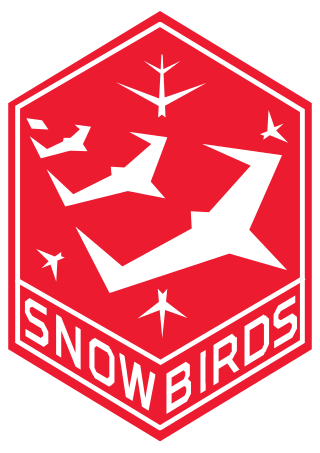
The Snowbirds, officially known as 431 Air Demonstration Squadron, are the military aerobatics flight demonstration team of the Royal Canadian Air Force. The team is based at 15 Wing Moose Jaw near Moose Jaw, Saskatchewan. The Snowbirds' official purpose is to "demonstrate the skill, professionalism, and teamwork of Canadian Forces personnel". The team also provides a public relations and recruiting role, and serves as an aerial ambassador for the Canadian Armed Forces. The Snowbirds are the first Canadian air demonstration team to be designated as a squadron.
The history of the Royal Canadian Air Force begins in 1914, with the formation of the Canadian Aviation Corps (CAC) that was attached to the Canadian Expeditionary Force during the First World War. It consisted of one aircraft that was never called into service. In 1918, a wing of two Canadian squadrons called the Canadian Air Force (CAF) was formed in England and attached to the Royal Air Force, but it also would never see wartime service. Postwar, an air militia also known as the Canadian Air Force was formed in Canada in 1920. In 1924 the CAF was renamed the Royal Canadian Air Force (RCAF) when it was granted the royal title by King George V. The RCAF existed as an independent service until 1968.

Shearwater Heliport, formerly known as Canadian Forces Base Shearwater and commonly referred to as CFB Shearwater and formerly named HMCS Shearwater, is a Canadian Forces facility located 4.5 nautical miles east southeast of Shearwater, Nova Scotia, on the eastern shore of Halifax Harbour in the Halifax Regional Municipality. Following a base rationalization program in the mid-1990s, the Canadian Forces closed CFB Shearwater as a separate Canadian Forces base and realigned the property's various facilities into CFB Halifax. These include:

The Canadair CT-114 Tutor is a jet trainer that was designed and produced by Canadian aircraft manufacturer Canadair. It served as the standard jet trainer of the Royal Canadian Air Force (RCAF), and later Canadian Armed Forces, between the early 1960s and 2000.

The Avro Canada CF-100 Canuck is a Canadian twinjet interceptor/fighter designed and produced by aircraft manufacturer Avro Canada. It has the distinction of being the only Canadian-designed fighter to enter mass production.

The Royal Canadian Air Force is the air and space force of Canada. Its role is to "provide the Canadian Forces with relevant, responsive and effective airpower". The RCAF is one of three environmental commands within the unified Canadian Armed Forces. As of 2020, the Royal Canadian Air Force consists of 12,074 Regular Force and 1,969 Primary Reserve personnel, supported by 1,518 civilians, and operates 258 manned aircraft and nine unmanned aerial vehicles. Lieutenant-General Eric Kenny is the current Commander of the Royal Canadian Air Force and Chief of the Air Force Staff.

The Canadian International Air Show (CIAS) is an annual air show in Toronto, Ontario, Canada. The show is an aeronautical display of military, government and civilian aircraft, primarily from Canada and the United States. The show takes place along Toronto's waterfront for three days during the Canadian Labour Day weekend. The show began in 1946 and has been held at Exhibition Place since 1949.

The Abbotsford International Airshow is held annually on the second Friday, Saturday and Sunday in August at Abbotsford International Airport in Abbotsford, British Columbia, Canada.

The McDonnell CF-101 Voodoo was an all-weather interceptor aircraft operated by the Royal Canadian Air Force and the Canadian Forces between 1961 and 1984. They were manufactured by the McDonnell Aircraft Corporation of St. Louis, Missouri for the United States Air Force, and later sold to Canada. CF-101s replaced the obsolete Avro CF-100 Canuck in the RCAF's all-weather fighter squadrons. The Voodoo's primary armament was nuclear AIR-2A Genie unguided air-to-air rockets, and there was significant political controversy in Canada about their adoption. Although they never fired a weapon in wartime, the CF-101 served as Canada's primary means of air defence from Quick Reaction Alert facilities at Canadian airbases. The CF-101s were retired in the 1980s and replaced with McDonnell Douglas CF-18 Hornet fighters. Many examples are preserved in museums and parks in Canada and the United States.

The Golden Hawks were a Royal Canadian Air Force (RCAF) aerobatic flying team established in 1959 to celebrate the 35th anniversary of the RCAF and the "Golden" 50th anniversary of Canadian flight, which began with the AEA Silver Dart in 1909.
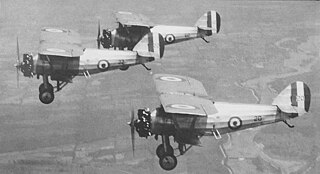
The Siskins, officially the Siskin Exhibition Flight, were a Royal Canadian Air Force (RCAF) aerobatic flying team that was established in 1929 at Camp Borden, Ontario. They were named after the bird family Siskin. It was the air force's first official aerobatic team. Flying three Armstrong Whitworth Siskin biplanes, the Siskins quickly built a reputation for performing daring maneuvers. The Siskins flew more than 100 air shows over three years before being disbanded in 1932 when the Great Depression forced the RCAF to reduce operations.
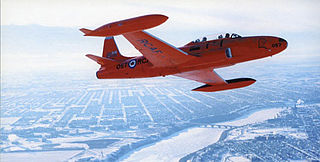
The Red Knight was a Canadian air force aerobatic display aircraft that operated from 1958 to 1969. The red-painted Silver Star performed loops, rolls, Cuban 8s, horizontal 360s, inverted flight, and high speed passes at airshows around North America, often appearing as an opening act for or in conjunction with the Golden Hawks display team and later the Golden Centennaires, Canada's contemporary aerobatic teams. The Silver Star was replaced by the Tutor in July 1968.
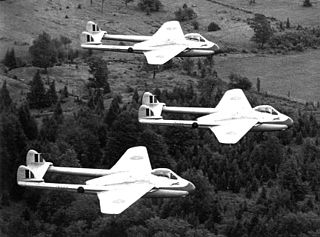
The Blue Devils or the 410 (F) Squadron Aerobatic Team was a Royal Canadian Air Force (RCAF) aerobatic team that flew the de Havilland Vampire jet aircraft from 1949 to 1951. The unit was the RCAF's first postwar aerobatic team, and belonged to the RCAF's first operational jet fighter squadron, No. 410 Squadron.

RCAF Station Grostenquin, also known as 2 (Fighter) Wing or 2 Wing, was a Royal Canadian Air Force (RCAF) station located five km north of the town of Grostenquin in the Moselle department, Lorraine, northeastern France. It was one of four RCAF wings, consisting of three fighter squadrons each, established in Europe in the early 1950s at the beginning of the Cold War. The other three wings were located at RCAF Station Marville in France, and RCAF Station Zweibrücken and RCAF Station Baden-Soellingen in the former West Germany.

Canadian Forces Base Trenton, formerly RCAF Station Trenton, is a Canadian Forces base located within the city of Quinte West, Ontario. It is operated as an air force base by the Royal Canadian Air Force (RCAF) and is the hub for air transport operations in Canada and abroad. Its primary RCAF lodger unit is 8 Wing, commonly referred to as 8 Wing Trenton. CFB Trenton is Canada's largest Air Force base and most southerly air base.

The Canadair Sabre is a jet fighter aircraft built by Canadair under licence from North American Aviation. A variant of the North American F-86 Sabre, it was produced until 1958 and used primarily by the Royal Canadian Air Force (RCAF) until replaced with the Canadair CF-104 in 1962. Several other air forces also operated the aircraft.
Lt. Col (Ret.) Joseph Armand Gerard Fernand Villeneuve was a Canadian aviator who joined the Royal Canadian Air Force (RCAF) in 1950 and was the first leader of the RCAF's Golden Hawks aerobatic team. He flew for 32 years as a military jet fighter pilot Villeneuve was inducted into the Canadian Aviation Hall of Fame in 2006.
Colonel Owen Bartley Philp, CM, DFC, CD was a Canadian air force officer who was instrumental in the formation of the Golden Centennaires aerobatic team, commanded the Golden Centennaires, and was founder of the Snowbirds aerobatic team. Philp was made a Member of the Order of Canada in October 1992 and was inducted into the Canadian Aviation Hall of Fame in 2015.
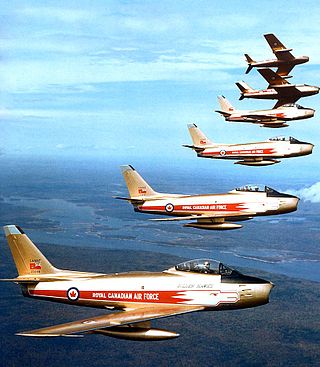
James David McCombe was a Royal Canadian Air Force (RCAF) pilot who was a commander of the Golden Hawks aerobatics team. His career with the RCAF spanned 23 years.
Air Defence Command was a command of the Royal Canadian Air Force and later the Canadian Armed Forces, active from 1951 to 1975.


















